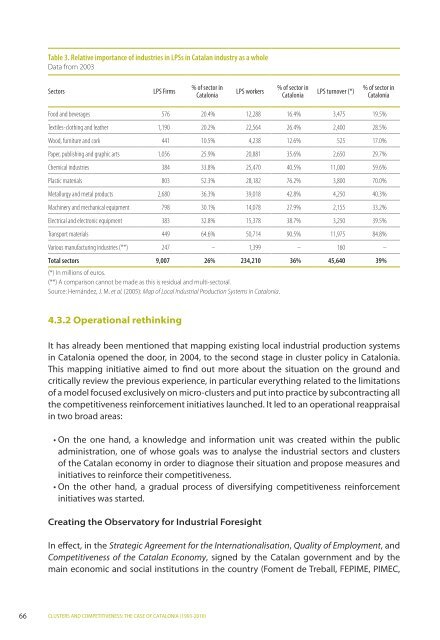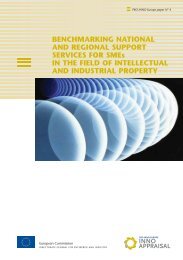Clusters and competitiveness - PRO INNO Europe
Clusters and competitiveness - PRO INNO Europe
Clusters and competitiveness - PRO INNO Europe
Create successful ePaper yourself
Turn your PDF publications into a flip-book with our unique Google optimized e-Paper software.
Table 3. Relative importance of industries in LPSs in Catalan industry as a whole<br />
Data from 2003<br />
Sectors LPS Firms<br />
% of sector in<br />
Catalonia<br />
66 CLUSTERS AND COMPETITIVENESS: THE CASE OF CATALONIA (1993-2010)<br />
LPS workers<br />
% of sector in<br />
Catalonia<br />
LPS turnover (*)<br />
% of sector in<br />
Catalonia<br />
Food <strong>and</strong> beverages 576 20.4% 12,288 16.4% 3,475 19.5%<br />
Textiles-clothing <strong>and</strong> leather 1,190 20.2% 22,564 26.4% 2,400 28.5%<br />
Wood, furniture <strong>and</strong> cork 441 10.5% 4,238 12.6% 525 17.0%<br />
Paper, publishing <strong>and</strong> graphic arts 1,056 25.9% 20,881 35.6% 2,650 29.7%<br />
Chemical industries 384 33.8% 25,470 40.5% 11,000 59.6%<br />
Plastic materials 803 52.3% 28,182 76.2% 3,800 70.0%<br />
Metallurgy <strong>and</strong> metal products 2,680 36.3% 39,018 42.8% 4,250 40.3%<br />
Machinery <strong>and</strong> mechanical equipment 798 30.1% 14,078 27.9% 2,155 33.2%<br />
Electrical <strong>and</strong> electronic equipment 383 32.8% 15,378 38.7% 3,250 39.5%<br />
Transport materials 449 64.6% 50,714 90.5% 11,975 84.8%<br />
Various manufacturing industries (**) 247 – 1,399 – 160 –<br />
Total sectors 9,007 26% 234,210 36% 45,640 39%<br />
(*) In millions of euros.<br />
(**) A comparison cannot be made as this is residual <strong>and</strong> multi-sectoral.<br />
Source: Hernández, J. M. et al. (2005): Map of Local Industrial Production Systems in Catalonia.<br />
4.3.2 Operational rethinking<br />
It has already been mentioned that mapping existing local industrial production systems<br />
in Catalonia opened the door, in 2004, to the second stage in cluster policy in Catalonia.<br />
This mapping initiative aimed to find out more about the situation on the ground <strong>and</strong><br />
critically review the previous experience, in particular everything related to the limitations<br />
of a model focused exclusively on micro-clusters <strong>and</strong> put into practice by subcontracting all<br />
the <strong>competitiveness</strong> reinforcement initiatives launched. It led to an operational reappraisal<br />
in two broad areas:<br />
• On the one h<strong>and</strong>, a knowledge <strong>and</strong> information unit was created within the public<br />
administration, one of whose goals was to analyse the industrial sectors <strong>and</strong> clusters<br />
of the Catalan economy in order to diagnose their situation <strong>and</strong> propose measures <strong>and</strong><br />
initiatives to reinforce their <strong>competitiveness</strong>.<br />
• On the other h<strong>and</strong>, a gradual process of diversifying <strong>competitiveness</strong> reinforcement<br />
initiatives was started.<br />
Creating the Observatory for Industrial Foresight<br />
In effect, in the Strategic Agreement for the Internationalisation, Quality of Employment, <strong>and</strong><br />
Competitiveness of the Catalan Economy, signed by the Catalan government <strong>and</strong> by the<br />
main economic <strong>and</strong> social institutions in the country (Foment de Treball, FEPIME, PIMEC,
















